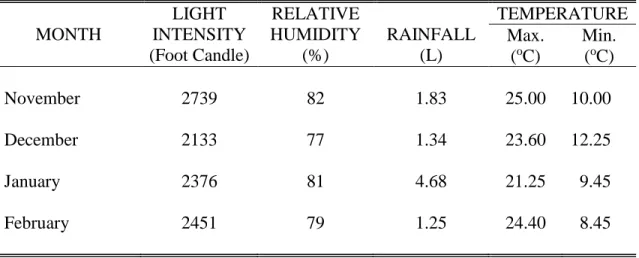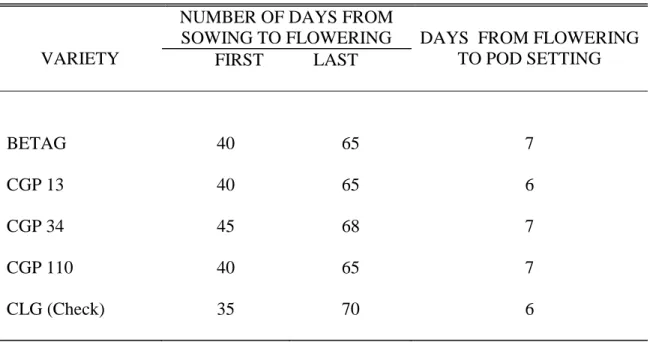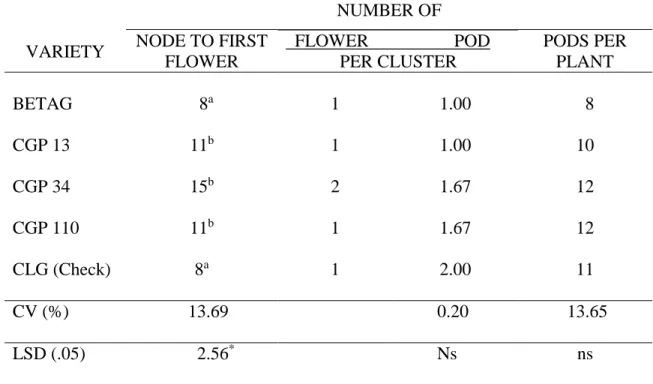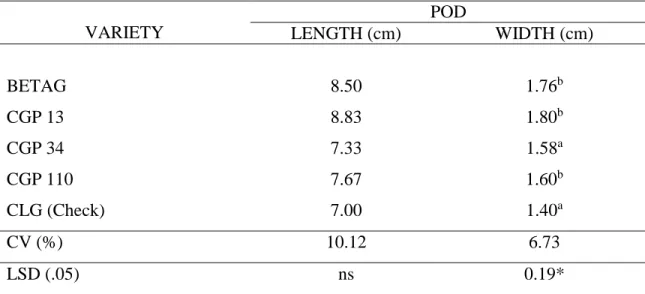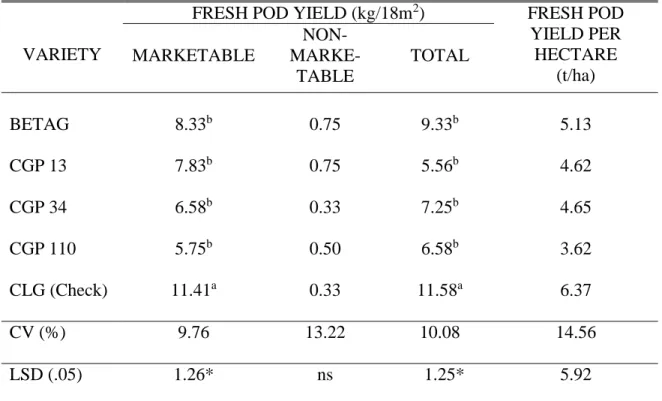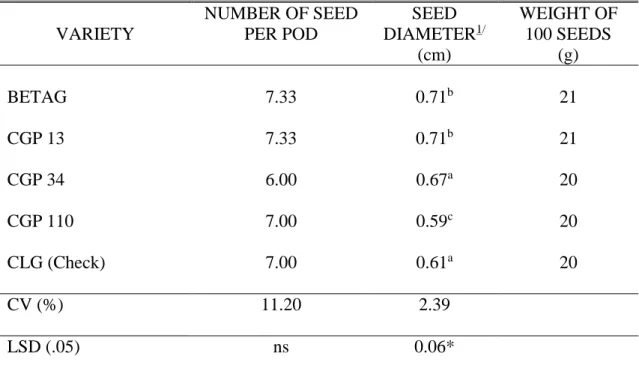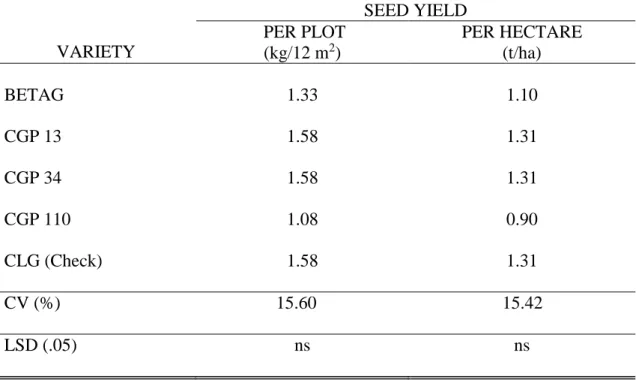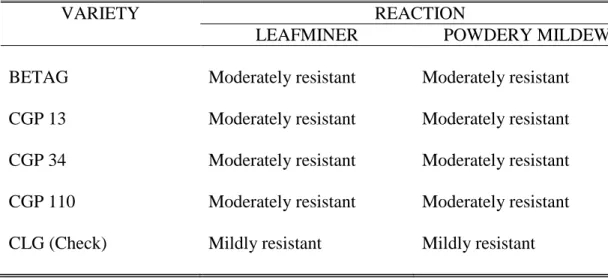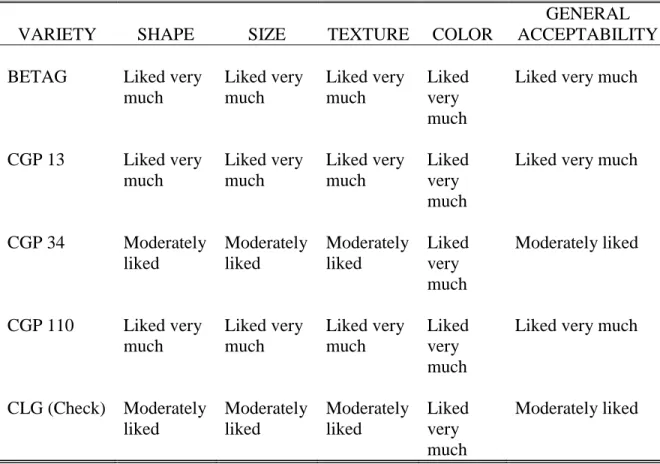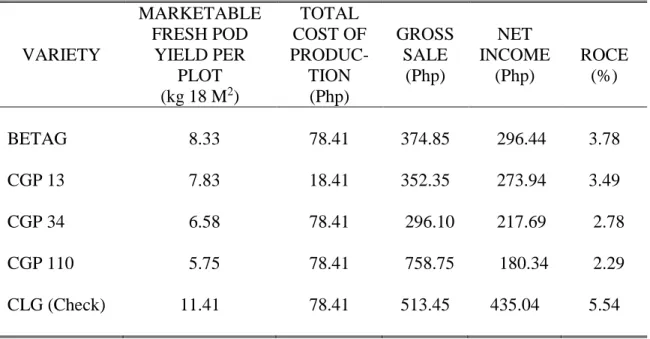BIBLIOGRAPHY
COMAFAY, MICHAEL JR. G. APRIL 2013. Evaluation of Fresh Pod and Seed Yield and Acceptability of Potential Garden Pea Varieties in Mankayan, Benguet.
Benguet State University, La Trinidad, Benguet.
Adviser: Leoncia L. Tandang, Ph.D.
ABSTRACT
Five garden pea varieties namely: Betag, CGP13, CGP34, CGP110 and CLG, the check variety were evaluated for fresh pod and seed yield profitability and acceptability to the farmers in Mankayan, Benguet from November 2012 to April 2013.
There were significant differences between the four garden pea varieties and the check variety, CLG on number of nodes to first flowering, number of pod per cluster, pod width, marketable fresh pod, seed diameter, total fresh pod and fresh pod yield per hectare.
CLG still significantly produced the higher fresh pod yield per plot and yield per hectare than all the varieties tested. All the varieties of garden pea evaluated had comparable seed yield. All of the varieties were profitable in Mankayan, Benguet.
Betag, CGP13 and CGP110 were highly acceptable by the farmers in Mankayan, Benguet.
INTRODUCTION
Garden pea (Pisum sativum), locally known as “sweet peas” in Benguet, is primarily grown for its fresh pod and edible green-shelled seed and also used as dry seed crop. It is an annual leguminous plant standing at about 3 to 5 feet high, herbaceous in nature consisting of one to three pairs of leaflets and terminal branches that can provide support and it has a compound leaves. The flower is borne one to two or three at the axil and is self-pollinated. The pod is about 3inches long and contains 4 to 9 seeds that maybe round or wrinkled or angular. This crop is believed to have originated in Europe or Asia and is commonly grown by the ancient Greeks and Romans (Ware and Swiader, 2002).
Garden pea is also one of the best sources of protein and is very important to nutrition. The Food and Nutrition Research Center (1964) mentioned that fresh green pod of garden pea contains about 57 cal, 3.3 protein, 0.3 fats, 13.0 CHO, and 35.0 minerals/100g edible protein. The green pods are good as viand while the seed are processed into canned products and the vine could be used for feeding livestock (Paganas, 2005). In addition, it also makes an important ingredient in soup, and any dish with bamboo shoot, mushrooms, and shrimps. Recognizing its importance to the industry, PCARRD-DOST identified garden pea as priority crop under the national vegetable R &
D program (PCARRD, 2011).
In warm places, garden pea is hard to grow since this crop thrives best in relative cool places. It helps maintain and conserve soil fertility because of its ability to fix free nitrogen from the atmosphere through the action of nitrogen fixing bacteria present in its roots (Ware and Swiader, 2002). Garden pea grows well in humus-rich or volcanic soil and
thrives best in area at least 1,000 m above sea level. It favors a cool climate with a temperature range of 10-18 0C.
Garden pea requires intensive care so local farmers grow them mainly for fresh pods. Few farmers venture into seed production, resulting to limited seed to use for the next cropping season so this tends to force seed dealers to introduce imported seeds for local distribution.
This is not only a constraint for the local farmers but it might also introduce new pest and diseases of the crop.
Highland farmers cannot identify the exact variety of garden pea which gives high yield with quality pods, and seed therefore, it is very important to evaluate garden pea varieties with high yield and quality pods and seeds and determine their acceptability and profitability of production in commercial growing areas. This study will be a great help to the farmers.
The study aimed to:
1. Evaluate the fresh pod and seed yield of potential garden pea varieties in Mankayan, Benguet;
2. Determine the acceptability and profitability of potential garden pea varieties in Doag, Guinaoang, Mankayan, Benguet; and
3. Identify the best varieties of garden pea that can be grown commercially in Mankayan, Benguet.
The study was conducted at Mankayan, Benguet from October 2012 to February 2013.
REVIEW OF LITERATURE
Large seeded legumes such as peas and beans are important sources of protein worldwide. In fact, they are dubbed as “poor man’s meat” in developing countries where meat is both scarce and expensive (Kudan, 1994).
The whole plant (mature or immature) provides forage for animal feed, immature pods produce sugar peas, immature seed produce green peas, and dry seed are suitable for all other uses (Shantalla et al., 2001).
They can be classified into the following classes based on main uses or market: green pea or vining peas for canning and freezing, dry peas, partly for human consumption but mostly for animal feed, forage peas, and sugar or market peas used a fresh vegetable for human consumption (Cousin, 1997). Oil from ripened seed has anti- sex harmonic effects;
produces sterility and antagonizes effect of male hormone. In Spain, flour is considered emullent and resolving applied as cataplasm it has been reported that seed contain trypsin and chymotypsin which could be used for contraceptives, ecbolic, as fungicide and spermicide (Duke, 1981).
Varietal evaluation is important in identifying the best variety suited to a given area and condition. High yielding, adapted and genetically improved cultivars are known to play an important role boosting production. The choice of variety is important. Gawidan (2006) stated that variety must be adapted to the area in which it is grown.
Garden pea is one of the most expensive vegetable in the country, the development of garden pea varieties locally, that are not only suitable to the climate of Benguet but also high yielding with superior pod qualities and better resistance to major pest and diseases should be given special attention to meet the need of farmers and consumers (Tandang et
al., 2009). BSU-IPB HCRS was able to develop new improved varieties of pole and bush
crop beans and garden pea with better yie1ld, pod qualities, and resistance to pest and diseases than the traditional varieties grown by the farmer like Kalantao for garden pea (Tandang, 2006). There is great variation in yielding ability of different varieties when grown under the same system.
Bay-an (2000) evaluated the performance and acceptability of six promising garden pea varieties produced by BSU-IPB HCRS in Atok, Benguet in 2000. Result revealed that all the six promising varieties were suitable to the locality because of their good yield performance ranging from 2.82 to 4.61 tons per hectare. The plant was also vigorous and mildly resistant to leaf miner. Taichung, 89-001, and Chinese garden pea were most preferred due to their small pods. Trinidad was the highest yielder but it was moderately liked because of its bigger pods.
Paganas (2005) characterized and evaluated five commercially grown varieties of garden pea in Benguet. The growth and yield performance differ among them, Kalantao, CGP 39 and 89-100 are identified as high yielding varieties. Kalantao, CGP 39 and 89-001 significantly produced the highest number and weight of marketable pods per plot and it is recommended to the garden pea growers in La Trinidad, Benguet.
Andres (2000) evaluated the growth and yield of three varieties of Garden pea in Bela, Bauko, Mt. Province. The varieties were Chinese Dark Green, Chinese White, and Kalantao. Base on the findings, Chinese white have the highest computed yield of 4.4 t/ha, while Chinese Dark Green had the lowest at 2 t/ha.
Dayag-an, in 2010 studied the growth and yield of ten promising lines of garden pea applied with organic fertilizers in La Trinidad, Benguet. Result revealed CGP 18A was
the earliest to produce flower and was the earliest to be harvested. CGP 59, CGP 154, and CGP 18A produced flower on 12th node while CGP 116 produced on flower on the 15th node. CGP 116 was the tallest and CGP 154 was the shortest among the promising line tested. CGP 18A, CGP 13 and 116 produced the longest pods and the shortest pod were harvested from CGP 11 and CGP 110. CGP 116 and CGP 18A produce the broadest pods and the CGP 110, CGP 59 and CGP11 produced a narrow pods. CLG and CGP 110 had the higher marketable pod per plot. CLG produced the highest total of marketable yield per plot and per hectare. CGP 110, CLG, 89-001 and CGP18a were the best promising line base on their maturity, growth and fresh pod length.
Beniasan (2010) evaluated several garden pea lines in Topdac, Atok, Benguet. CGP 18A significantly had the longest and widest pods. Yield did not significantly differ but higher marketable yield was obtained from CGP 110, CLG, CGP 34 and CGP18A, also all of them had the higher return of investment. Farmers preferred CGP 110 and CGP18A based on pod shape, size and color.
Doli (2000) evaluated Garden pea varieties at Batan, Kabayan, Benguet. The BSU- IPB CGP 18A had significantly higher number of nodes from flowering to the pod setting, remarkably higher in CGP 11 and CGP 14, CGP 11 produced longer and wider pods, BSU- IPB CGP 18A produce more number of seed per pod, CGP 11 and CGP 14 had the higher marketable pod yield. CGP 11 and CGP 14 were the most adapted entries in that locality.
On farm evaluation of promising garden pea varieties in Madaymen, Kibungan, Benguet was conducted by Del-amen in (2010). The six promising lines of garden pea significantly differ in days from emergence to flowering, leaf size, plant height, at 35 days after planting, node bearing first flower and pod per cluster, fresh pod yield per 10m2 plot
and profitability. All the lines had comparable maturity indices, plant height at harvest, pod size and resistance to leaf miner and powdery mildew. CGP110 and Kalantao produced the highest marketable and total fresh pod yield per 10m2 plot with 133% and 126% return on cash expense while as CGP110 was liked very much by the
farmers in Kibungan in terms of pod appearance, pod color and crunchiness and general acceptability.
Leguminous crops are planted at the end of rainy season (Ware and Swaider, 2008).
However, Agwiking (1998) as cited by Gawidan (2006) found that leguminous crop can also be planted during the later part of dry season to avoid pest and diseases which are more susceptible during rainy season.
Peas can be grown successfully during mid summer and early fall in those areas having relative low temperatures and good rain-fall, or were irrigation is practiced. For very early crops, sandy loam is preferred; for large yield where earliness is not a factor, as well drained clay loam or silt loam is preferred (Duke, 1981).
Lab-oyan (2011) studied the yield performance of two garden pea varieties as influenced by rate of vermin-compost application. Application of vermi-compost fertilizer improved the growth and yield performance of the two varieties of garden pea. Vermi- compost application showed a great influence to the bulk density and water holding capacity of the soil increasing the yield performance of garden pea. Dayag-an in 2010 stated that application of vermi-compost increased marketability and total fresh pod yield of garden pea. CGP 110 and CLG are best grown with vermin-compost application.
Wanas in 2009 determined the efficacy of vermin-compost on the yield of garden pea. Pod length of garden pea was not affected by vermin-compost application. Increasing
the application of vermin-compost from 5 to 40 tons per hectare increased the pod yield of garden pea.
Anas in 2008 studied the effect of different activators like treated and untreated chicken manure significantly affects the length of pods, pod yield per plot, and computed yield per hectare. Garden pea pods were longer with the application of six tons per hectare chicken manure. Two tons per hectare application of chicken manure gave the highest pod yield per plot for the garden pea. Application of activator treated chicken manure at two tons per hectare registered, the highest pod yield per plot, computed yield per hectare and consequently had the higher return on investment.
Garden peas are harvested when the pods are fully green and well developed but still tender.
The seed should be near full size and should not begun to harden. Pea pods intended for dry peas or seed should be harvested when they start to yellow or begin to dry up (Ware and Swaider, 2002).
MATERIALS AND METHODS
A total area of 480m2 was thoroughly prepared and divided into 75 plots with a dimension of 1m x 6m each. Each experimental unit consisted of 5 plots wherein the outer 2 plots were intended for dry seed production and the inner 3 plots were intended for fresh pod production.
The four garden pea entries used in the study were variety CGP13, Betag, CGP 34, and CGP110. They were taken from Benguet State University-Institute of Plant Breeding- Highland Crop Research Station (BSU-IPB-HCRS) and Chinese Light Green (CLG) was obtained from farmers and served as the check variety (control).
Basal application of processed chicken manure at a rate of 0.25 kg and application of 14- 14-14 was done at a rate of 1.5 kg per plot, and was mixed thoroughly with the soil. There were two rows per plot. The distance between rows and between hills was 20cm. Two seeds were sown per hill at a depth of 2cm. The experiment was laid out following the Randomized Complete Block Design (RCBD) with three replications.
Trellises were provided where the vines were bound with plastic twine. Other cultural practices like irrigation, fertilization and crop protection were done when needed.
Description of the Location
The study was conducted at Sitio Doag, Guinaoang, Mankayan, Benguet.
Guinaoang is located on the eastern part of Mankayan. It is bounded by Bulalacao on the north; Taneg on the south; Buguias municipality on the East; and Suyoc (Palasaan) on the west. These boundaries are defined by natural borders such as mountain peaks, ranges, river and creeks.
The barangay is characterized by rugged terrain ranging from 0-100% slope. Based on agriculture studies, clay soil dominated in the area. Guinaoang has an average maximum temperature of 24oC at and minimum temperature of 14oC. The coolest month of the year starts from December and extend up to the last week of February. It is classified under type I climate having pronounce season, dry from November to April and wet during the rest of the year.
The following data were gathered:
1. Meteorological data. Light intensity, relative humidity and temperature, were taken by using digital hygroscometer while rainfall was collected and measured,
2. Description of the location. This was taken from the profile of the Barangay and or Municipality.
3. Number of days from sowing to emergence. This was recorded by counting the number of days from sowing to emergence when 80% of the seed sown had fully emerged.
4. Number of days from emergence to the first flowering. This was recorded by counting the number of days from emergence to the time when 50% of the plant in the plot has at least two fully opened flowers.
5. Number of nodes to first flower. This was the number of nodes from ground surface to the node where the first flower appeared.
6. Number of days from emergence to last flowering. This was recorded by counting the number of days from emergence to last flowering when 50% of the plant in the plot had stopped flowering.
7. Number of days from flowering to pod setting. This was obtained by counting the number of days from flowering until the pod is fully developed.
8. Number of flower per cluster. This was obtained by counting the number of flower per cluster using 10 sample clusters per-plot per replication.
9. Number of pod per cluster. This was obtained by counting the number of pods per cluster from10 sample clusters per replication.
10. Number of pods per plant. This was recorded by counting the number of pods from 10 samples plants per replication.
11. Pod length (cm). This was obtained by measuring the length of 10 sample pods per treatment from the base to the tip of the pods.
12. Pod width (cm). This was obtained by measuring the broadest part of 10 pods used in gathering pod length.
13. Total weight of pods per plot (kg). This was the total weight of marketable and non- marketable pods. Marketable pods are well formed and free from damages and disease while non-marketable pods are malformed, and damaged by pest and diseases.
14. Total weight of marketable pods per plot (kg). This was the total weight of marketable pods. Marketable pods were well formed pods and free from damages.
15. Total weight of non-marketable pods per plot (kg). This was the total weight non- marketable pods. Non-marketable pods were malformed pods, and damaged by pest and diseases.
16. Number of seed per pod. The number of seed per pod from 10 sample pods used in gathering pod length and width was counted and recorded.
17. Dried seed diameter (cm). The diameter of the seed was measured at harvest from 10 sample seeds selected at random. This will be measured parallel to the hillum using foot rule.
18. Weight of 100 seeds (g). The harvested seeds were sun dried continuously for eight days to lower moisture content to about 10%. One hundred seeds were randomly picked and weighed.
19. Total seed per plot (kg/12m2). This was the total seed yield per plot taken after seven days of continuous sun drying.
20. Computed fresh pod and seed yield per hectare. This was obtained based on yield per plot in kg/6m2 using the formula:
Yield (t/ha) = Fresh pod Yield per plot (kg/18m2) x 0.55 and Seed yield per plot (kg/12m2) x 0.83 where: 0.55 and 0.83 were factors used to convert fresh pod yield/18m2 and seed yield per plot kg/12m2 to yield per hectare in T/ha assuming a total of one hectare effective area.
21. Reaction to Leaf miner infestation. This was determined using the following scale used by Tandang et al (2008).
Scale Description Remarks
1 No Infestation Highly resistant 2 1-25% Infestation Mildly resistant 3 26-50% Infestation Moderately resistant
Scale Description Remarks 4 51-75% Infestation Susceptible 5 76-100% Infestation Very susceptible
22. Reaction to powdery mildew. This was determined using the following scale used by Tandang et al. (2008):
Scale Description Remarks
1 No Infection Highly resistant 2 1-25% Infection Mildly resistant 3 26-50% Infection Moderately resistant 4 51-75% Infection Moderately susceptible 5 76-100% Infection Very susceptible
23. Farmer’s acceptability. Ten farmers were invited to make their own selection and express their reasons for accepting and not accepting the selected potential varieties of garden pea. Selection was based on the fresh pod yield and quality after harvest. Hedonic scale for sensory evaluation of root crops as cited by Tandang (1998) was used as follows:
Pod Characters
a. Pod texture. This was taken by touching the pod and the texture was noted either smooth or rough.
b. Pod straightness. This was recorded as either straight or curve.
c. Pod shape. This was recorded as flat or round.
d. Pod color. This was recorded as green, dark green or light green when the pods were fully develop.
24. Return on Cash Expense (ROCE). All expenses per plot were recorded and gross income was computed; the return on cash expense (ROCE) was determined using the following formula:
ROCE (%) = Gross Sales – Total Expenses x 100 Total Expenses
Data Analysis
The data were statistically analyzed using the analysis of the variance for Randomized Complete Block Design (RCBD) with three replications. The significance of differences among the treatment means was tested using LSD.
RESULTS AND DISCUSSION
Meteorological Data
The temperature, rainfall and relative humidity during the conduct of study are shown in Table 1. The maximum temperature ranged from 21.25oC to 25.00oC while the minimum temperature ranged from 8.9oC to 10oC.
The relative humidity was recorded ranged from 82% to 98.5%. A high amount of rainfall was recorded in the month of January of 4.68 liters and decreased in the month of February of 1.25 liters.
The longest daily light intensity was observed in the month of February and the lowest was in the month of December.
Table 1. Light intensity, relative humidity, rainfall and average temperature from November 2012 to February 2013
MONTH
LIGHT INTENSITY (Foot Candle)
RELATIVE HUMIDITY
(%)
RAINFALL (L)
TEMPERATURE Max.
(oC)
Min.
(oC) November
December January February
2739 2133 2376 2451
82 77 81 79
1.83 1.34 4.68 1.25
25.00 23.60 21.25 24.40
10.00 12.25 9.45 8.45
Number of Days from Sowing to Emergence and to First and Last Flowering
All the garden pea varieties evaluated, emerged in seven days except for CLG which emerged one day earlier. Among the five varieties of garden pea evaluated, CLG was the earliest to flower within 3-5-days after sowing (DAS). The other varieties flowered five days later except for CGP 34 which flowered after 45 DAS, 10 days later than the CLG, the check variety. Most of the varieties tested, produced the last flower at 65 DAS except CGP 34 which had its last flowering 68 DAS, 3 days earlier than CLG which had last flowering 70 DAS (Table 2).
Number of Days from Flowering to Pod Setting
Number of days from flowering to pod setting was observed. It was found that CLG, the check variety and CGP13 took fewer days from flowering to pod setting with
Table 2. Number of days from sowing to emergence, first and last flowering and days from planting to pod setting of five varieties of garden pea evaluated in Mankayan, Benguet
VARIETY
NUMBER OF DAYS FROM
SOWING TO FLOWERING DAYS FROM FLOWERING TO POD SETTING FIRST LAST
BETAG CGP 13 CGP 34 CGP 110 CLG (Check)
40 40 45 40 35
65 65 68 65 70
7 6 7 7 6
both 6 days from flowering to pod setting. There was no significant difference that was observed from the five variety of garden pea (Table 2).
Number of Nodes from the Base that Produced First Flower
Table 3 shows the number of nodes from the base that produced the first flower.
CLG (check variety) and Betag had significantly lower number of node with eight nodes to first flower while CGP13, CGP34 and CGP110 significantly higher number of nodes from the base to first flower.
Table 3. Number of node to first flowering, number of flower and pod per cluster and number of pods per plant of potential varieties evaluated in Mankayan, Benguet
VARIETY
NUMBER OF NODE TO FIRST
FLOWER
FLOWER POD PER CLUSTER
PODS PER PLANT BETAG
CGP 13 CGP 34 CGP 110 CLG (Check)
8a 11b 15b 11b 8a
1 1 2 1 1
1.00 1.00 1.67 1.67 2.00
8 10 12 12 11
CV (%) 13.69 0.20 13.65
LSD (.05) 2.56* Ns ns
Within a column means followed by the same letters as the check variety are not significantly different at 5% level of significance using LSD with the check variety.
Number of Flower and Pod per Cluster and per Plant
Apparently, the number of flower per cluster ranged from one to two flowers per cluster in CLG, CGP110 and CGP13 , Betag had only one flower per cluster while CGP34 produced two flowers per cluster (Table 3).
No significant differences were observed in number of pod per cluster among the five garden pea varieties evaluated. All of the varieties had one pod per cluster except CLG which produced 2 pods per cluster.
Table 3 also shows the number of pod per plant of the five varieties of garden pea studied in Mankayan, Benguet. CGP34 and CGP110 numerically had the highest number of pods per plant (12). CLG, the check variety produced 11 pods per plant. Betag produced the lowest number of pods (8) per plant.
Pod Length and Width
Table 4 shows the pod length and width of the five garden pea varieties evaluated in Mankayan, Benguet. It was observed that all the five varieties tested had comparable pod length which ranged from 7.00 to 8.83 cm pod length and CLG had the shortest pods while CGP 13 had the longest pods.
It was observed that there was significant difference among the five garden pea varieties evaluated. CLG and CGP34 had narrow pod while Betag, CGP13 and CGP110 had significantly widest pod width.
Table 4. Pod length and width of five potential varieties of garden pea evaluated in Mankayan, Benguet
VARIETY
POD
LENGTH (cm) WIDTH (cm)
BETAG CGP 13 CGP 34 CGP 110 CLG (Check)
8.50 8.83 7.33 7.67 7.00
1.76b 1.80b 1.58a 1.60b 1.40a
CV (%) 10.12 6.73
LSD (.05) ns 0.19*
Within a column means followed by the same letters as the check variety are not significantly different at 5% level of significance using LSD with the check variety.
Fresh Pod Yield per Plot and per Hectare
CLG had significantly the highest weight of marketable pod of 11.41 kg/18 m2. All the rest of the varieties evaluated were significantly lower in terms of marketable fresh pod yield with mean yield of 5.75 to 8.33 kg/18m2 (Table 5). Non-marketable pods ranged from 0.33 (CLG) to 0.75 (Betag and CGP13). CLG had the highest total yield with 11.58 kg/18m2 while the other varieties had a lower total yield. In terms of fresh pod yield per hectare, there was no significant differences among the garden pea varieties evaluated.
CLG had the numerically highest production of fresh pod but it was significantly higher than the four potential garden pea varieties evaluated (Table 5).
Table 5. Fresh pod yield per plot (kg/18m2), total weight of marketable pod per plot (kg/18m2) and weight of non-marketable pods per plot of five varieties of garden pea evaluated in Mankayan, Benguet
VARIETY
FRESH POD YIELD (kg/18m2) FRESH POD YIELD PER
HECTARE (t/ha) MARKETABLE
NON- MARKE-
TABLE
TOTAL
BETAG CGP 13 CGP 34 CGP 110 CLG (Check)
8.33b 7.83b 6.58b 5.75b 11.41a
0.75 0.75 0.33 0.50 0.33
9.33b 5.56b 7.25b 6.58b 11.58a
5.13 4.62 4.65 3.62 6.37
CV (%) 9.76 13.22 10.08 14.56
LSD (.05) 1.26* ns 1.25* 5.92
Within a column means followed by the same letters as the check variety are not significantly different at 5% level of significance using LSD with the check variety.
Number of Seed per Pod
It was observed that there were no significant differences between the CLG, the check variety and the four varieties of garden pea (Table 6).
Seed Diameter
Significant differences was observed from five garden pea evaluated (Table 6).
Seed diameter of the evaluated garden pea varieties were ranged from 0.59 cm (CGP110) to 0.71 (Betag and CGP110).
Table 6. Number of seeds per pod, seed diameter and weight of 100 seeds of five varieties of garden pea evaluated in Mankayan, Benguet
VARIETY
NUMBER OF SEED PER POD
SEED DIAMETER1/
(cm)
WEIGHT OF 100 SEEDS
(g) BETAG
CGP 13 CGP 34 CGP 110 CLG (Check)
7.33 7.33 6.00 7.00 7.00
0.71b 0.71b 0.67a 0.59c 0.61a
21 21 20 20 20
CV (%) 11.20 2.39
LSD (.05) ns 0.06*
1/Within a column means followed by a) comparable with the check variety; b) significantly higher with the check variety and c) significantly lower with the check variety at 5% level of significance using LSD with the check variety.
Weight of 100 Seeds
There was no significant differences among the garden pea varieties evaluated (Table 6). It was observed that CLG, CGP110 and CGP34 had 20 g weight of 100 seeds while Betag and CGP13 had 21 g weight of 100 seeds.
Seed Yield
There was no significant differences observed between the check variety (CLG) and the four garden pea varieties evaluated. The lowest number was obtained from CGP110 while CLG, CGP34 and CGP13 had comparably had the highest seed yield with 1.31 t/ha (Table 7).
Table 7. Seed yield per plot (kg/12m2) and seed yield (tons/ha) of five varieties of garden pea evaluated in Mankayan, Benguet
VARIETY
SEED YIELD PER PLOT
(kg/12 m2)
PER HECTARE (t/ha) BETAG
CGP 13 CGP 34 CGP 110 CLG (Check)
1.33 1.58 1.58 1.08 1.58
1.10 1.31 1.31 0.90 1.31 CV (%) 15.60 15.42
LSD (.05) ns ns
Total Seed Yield per Plot
No significant differences that were observed from the five garden pea varieties evaluated (Table 7). CLG had 1.58 kg/12 m2 comparable to CGP13 and CGP34 while 1.08 kg/12 m2 was obtained from CGP110.
Reaction to Leaf Miner and Powdery Mildew
All the varieties evaluated were moderately resistance to leaf miner infestation and powdery mildew except CLG, which was observed to have mild resistance to leaf miner infestation and powdery mildew (Table 8). The resistance could be due to the inherent characteristic of the varieties, or it is possible that the prevailing climatic condition during the study.
Table 8. Reaction to leaf miner and powdery mildew of five varieties of garden pea in Mankayan, Benguet
VARIETY REACTION
LEAFMINER POWDERY MILDEW
BETAG CGP 13 CGP 34 CGP 110 CLG (Check)
Moderately resistant Moderately resistant Moderately resistant Moderately resistant Mildly resistant
Moderately resistant Moderately resistant Moderately resistant Moderately resistant Mildly resistant
Farmers Acceptability
In terms of shape of pod among the five varieties of garden pea, Betag, CGP13, CGP110 were liked very much by farmers while CGP34 and CLG were moderately liked by the farmers.
In terms of texture, Betag, CGP13 and CGP110 were liked very much by the farmer while CGP34 and CLG was moderately liked by the farmers. In terms of color, all the varieties evaluated was like very much by the farmer while for general acceptability, Betag, CGP 13, CGP110 was liked very much by the farmers and moderately liked was obtained from CGP34 and CLG (Table 9).
Table 9. Farmers acceptability of five garden pea varieties
VARIETY SHAPE SIZE TEXTURE COLOR
GENERAL ACCEPTABILITY BETAG
CGP 13
CGP 34
CGP 110
CLG (Check)
Liked very much
Liked very much
Moderately liked
Liked very much
Moderately liked
Liked very much
Liked very much
Moderately liked
Liked very much
Moderately liked
Liked very much
Liked very much
Moderately liked
Liked very much
Moderately liked
Liked very much Liked very much Liked very much Liked very much Liked very much
Liked very much
Liked very much
Moderately liked
Liked very much
Moderately liked
Return on Cash Expense
All of the garden pea varieties had positive ROCE. CLG, the check variety had the highest ROCE for fresh pod and seed yield production. CGP34 and CGP110 were significantly lower than CLG, Betag and CGP13 (Tables 10 and 11).
The positive ROCE implies that all the varieties are profitable.
Table 10. Return on cash expense (ROCE) on growing five garden pea varieties for fresh pod production in Mankayan, Benguet
VARIETY
MARKETABLE FRESH POD
YIELD PER PLOT (kg 18 M2)
TOTAL COST OF PRODUC- TION (Php)
GROSS SALE
(Php)
NET INCOME
(Php)
ROCE (%)
BETAG CGP 13 CGP 34 CGP 110 CLG (Check)
8.33 7.83 6.58 5.75 11.41
78.41 18.41 78.41 78.41 78.41
374.85 352.35 296.10 758.75 513.45
296.44 273.94 217.69 180.34 435.04
3.78 3.49 2.78 2.29 5.54
Table 11. Return on cash expense (ROCE) on growing five garden pea varieties for seed production in Mankayan, Benguet
VARIETY
SEED YIELD PER PLOT
kg/12 m2)
TOTAL COST OF PRODUC- TION
(Php)
GROSS SALE
(Php)
NET INCOME
(Php)
ROCE (%)
BETAG CGP 13 CGP 34 CGP 110 CLG (Check)
1.33 1.58 1.58 1.08 1.58
65.45 65.45 65.45 65.45 65.45
199.50 237.00 237.00 162.00 237.00
134.05 171.55 171.55 96.55 171.55
2.04 2.62 2.62 1.47 2.62
*Total cost of production included only the cost of planting materials, fertilizers, chemicals and trellis
*Selling price of fresh pods and seed yield of garden pea is based on the price of the market for fresh pod at 45 per kilo and 150 per kilo for seed yield.
SUMMARY, CONCLUSION AND RECOMMENDATION
Summary
Five garden pea varieties were evaluated to identify the best yielding variety for fresh pod and seed yield and its acceptability and profitability in Mankayan, Benguet.
There was significant differences between the check variety, CLG and the four potential garden pea varieties evaluated, number of nodes to first flowering, number of pod per cluster, pod width, total weight of pods per plot, total weight of marketable pods per plot, seed diameter and fresh pod (t/ha).
CLG, still significantly produced the highest fresh pod yield per plot and yield per hectare than all the varieties evaluated.
All the varieties of garden pea evaluated had comparable seed yield. All of the varieties were grown profitable in Mankayan, Benguet. Betag, CGP13 and CGP110 were highly acceptable by the farmer in Mankayan, Benguet.
CLG, check variety was observed to have mildly resistance against leaf miner and powdery mildew infestation while the rest of the varieties evaluated showed moderately resistant against the two most important pest and diseases of garden pea. CLG, still had the highest return on cash expense (ROCE).
Conclusion
CLG, which is the check variety had the highest fresh pod yield among the five garden pea varieties evaluated. The four varieties of garden pea had comparable seed yield with CLG (check variety).
Betag, CGP13 and CGP110 were liked very much by the farmers in Mankayan, Benguet while CGP34 and CLG were moderately liked.
Betag and CGP13 were most preferred by the farmers due to their pod size, pod shape, pod color and pod texture. All the garden pea varieties evaluated were profitable in Mankayan, Benguet.
Recommendation
CLG, CGP 13, Betag and CGP110 are recommended for fresh pod production. All the varieties are recommended for seed yield production in Mankayan, Benguet.
The five potential garden pea varieties could be grown by the farmers for higher income.
LITERATURE CITED
ANDRES, T. 2000. Highland Agriculture R & D Highlights. BFI Complex, Guisad, Baguio, City: Department of Agriculture Region 1. Pp. 34-35.
ANAS, L. C. 2008. Influence of activator on chicken manure utilization by garden pea (Pisumsativum) and some soil properties. BS Thesis. Benguet State University. BSU, La Trinidad, Benguet. Pp. 43-44.
BAY-AN, M. B. 2000. Performance and acceptability of promising garden pea varieties in Atok, Benguet. BS Thesis. BSU, La Trinidad, Benguet. Pp. 2-17.
BENIASAN, E. T. 2010. Pilot testing of garden pea (Pisum sativum L.) lines under Topdac, Atok, Benguet condition. BS Thesis. Benguet State UniversityBSU, La Trinidad, Benguet.
P. 37.
COUSIN, R. 1997. Peas (Pisum sativum L.). Field crop research. 53: 111-130.
DAYAG-AN, J. G. 2010. Growth and yield of ten promising lines of garden pea applied with organic fertilizer in La Trinidad, Benguet. BS Thesis. Benguet State University, La Trinidad, Benguet. P. 42.
DEL-AMEN, M. B. 2010, On farm evaluation of promising garden pea varieties in Madaymen, Kibungan, Benguet. BS Thesis. Benguet State University, La Trindad, Benguet. P. 40.
DOLI, R. T. 2000. Evaluation of aarden pea (Pisum sativum) at Batan, Kabayan, Benguet.
BS Thesis. Benguet State University, La Trinidad, Benguet. P. 22.
DUKE, J. A. 1981. Hand Book of Legume of World Economic importance. Plenum Printing Press, New York. Pp. 199-265.
GAWIDAN, L. D. 2006. Fresh pod and Seed yield of Garden pea entries in La Trinidad, Benguet. BS Thesis. BSU, La Trinidad, Benguet. Pp. 2-15.
LAB-OYAN, C. F. 2011. Yield performance of two garden pea varieties (Pisum sativum) as influence by rates of Vermi compost. Benguet State University, La Trinidad, Benguet.
Pp. 24-25.
KUDAN, S. L. 1994. Evaluation of x-ray radiography assessing, seed quality of dicotyledonous seed with particular reference to pea (Pisum sativum). Post Graduate Diploma Thesis. Seed Technology Center, Massey University, Palmerston North, New Zealand. Pp. 1-2.
PAGANAS, A. M. 2005. Characterization and evaluation of commercially grown garden varieties in Benguet. BS Thesis. BSU, La Trinidad, Benguet. Pp. 2-5.
PHILIPPINE COUNCIL FOR AGRICULTURE, FORESTRY AND NATURAL RESEARCH AND DEVELOPMENT (PCARRD). 2011. Retrieved August 3, 2011 from http:// maidon. Pcarrd. Dost .gov.ph / joomla / index. Php? = com_ content &tast = view
& id = 836 & itemed = 590.
SHANTALA, M. , J. M. AMURRIO AND A. M. DERON. 2001. Symbiotic interaction between Rhizobium leguminosarum strains and Elite cultivars of Pisum sativum L. J.
Agronomy and crop science 189: 59-68.
TANDANG, L. L., A. M. KIMEU, B.A. AMLOS, J. G. BAGTILA, B. B. KEBASEN, and C. R MAGHIRANG. 2008. Benguet State University In-House Review Report Format for Completed Projects. Benguet State University, La Trinidad, Benguet. P. 19.
TANDANG, L. L. 2006. Development of Snap Bean (Phaseolus vulgaris) and Garden pea (Pisum sativum L.) in Benguet, Philippines. Philippine Agriculture and Resources Research Foundation Inc. (PARRFI). Pp. 141-148.
WARE, G.W. AND J. M. SWIADER. 2002. Producing vegetable crop. The Interstate Printer and Publishers, Inc., USA. Pp. 427-439.
WANAS, F. M. 2009. Rate of Vermi compost fertilization on the yield of Garden pea (Pisum sativum L.). BS Thesis. Benguet State University, La Trinidad, Benguet. Pp. 9, 31.
